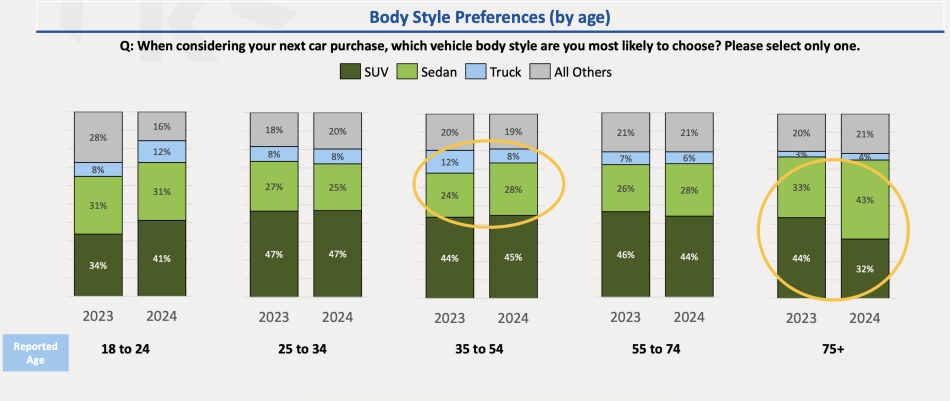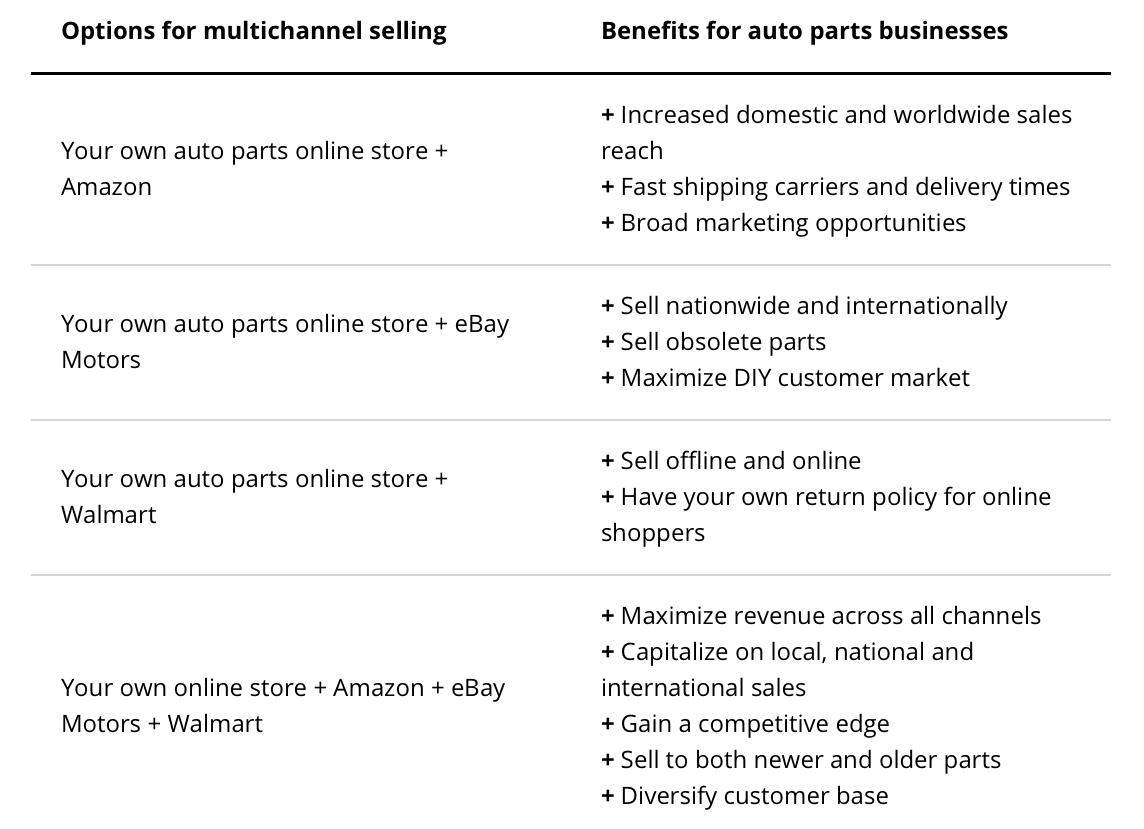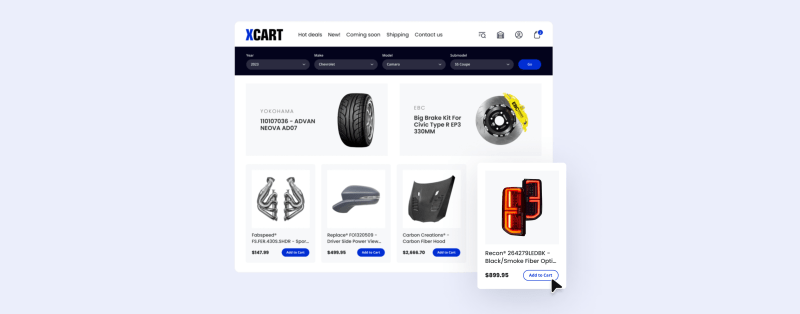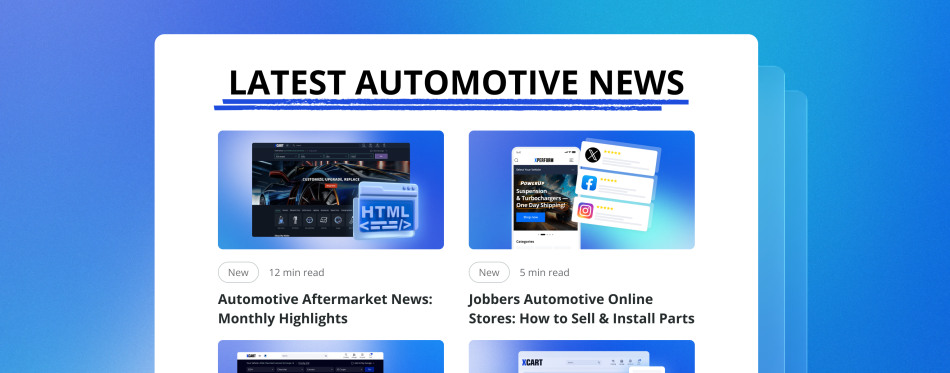How to Sell Car Parts Online: Profit-Driven Strategies for Automotive Businesses
Published: June 27, 2023. Updated: March 17, 2025
Whether you are a newbie in the auto parts eCommerce world or a seasoned auto parts seller, you always look for new ways to enhance your sales strategy, adjust your business goals, grow brand awareness, and beat the competition. Look no further.
Our complete guide to selling auto parts online will explain essential steps to making your automotive store successful and equip you with the tools and techniques to start and run a profitable eCommerce business.
This blog post covers how to identify top-selling goods, better understand consumer behavior, select appropriate eCommerce software, and connect with reliable automotive catalog providers and warehouse distributors.
1. Know the market: Picking the right niche
Choosing the right niche is crucial for succeeding online. While it might be tempting to partner with a distributor like Turn 14 Distribution, Inc., Meyer Distributing, or American Tire Distributors, import a massive catalog, and hope a broad audience finds what they need, the reality is that this “Field of Dreams” approach puts you up against intense competition and requires a huge effort to make your products appealing and easy to find.
In contrast, narrowing your focus to a specific part type, vehicle model, or enthusiast group gives your customers a clear, targeted shopping experience.
We’re seeing far more success from store owners who narrowly define their target market. Starting with a niche doesn’t mean you’re boxed in. Many of our clients have begun with a tight focus, gained traction, and only then expanded into new lines or vehicle models. They didn’t try to be the “Amazon of auto parts” from day one. Instead, they took a reasonable path to growth until they were well-funded and strategically positioned to compete.
For example, a website dedicated to Ford F-150 accessories can showcase F-150-specific products like truck bed covers, running boards, and bed liners on their homepage and social media channels. This focused strategy resonates with F-150 owners and enables the brand to connect on forums, share helpful advice, and publish relevant content that builds trust and loyalty. Thus, a niche-focused online store with the right basics in place almost markets itself.

The essential steps to identifying a profitable car parts niche:
1. Identify target market: Analyze potential buyers based on age, gender, location, vehicle preferences, and specific market demands.
2. Research competition: Look for opportunities to differentiate yourself, such as selling popular auto parts, overlooked by your competitors or offering unique customer service.
3. Engage with automotive communities: Explore forums and enthusiast groups to understand popular vehicle models, industry trends, and specific customer needs.
4. Assess pricing strategies: Determine the margins you can afford, understand manufacturer prices, calculate the cost of shipping, and estimate potential logistics issues.
2. Know the demand: Best-selling auto parts
With the fast-paced nature of the automotive industry, top-selling products can shift from month to month. However, some products consistently remain popular despite these changes.
Wheels and Tires
Actually, the more accurate word choice will be ‘wheels and suspension’ as it includes everything from wheels to tires to shocks and struts to hubcaps.
Wheels and tires, often classified as external parts due to their similar selling patterns, actually represent a distinct niche with its own unique selling points. These include the need for a specific shipping plan to facilitate their delivery and the requirement for accurate fitment data from automotive suppliers, which sets them apart from other automotive products.
Expert tip: When selling wheels and tires online, it’s essential to provide your customers with tools that enhance their shopping experience. This includes enabling them to narrow their search through advanced filtering options such as diameter, width, offset, and tread width. Additionally, a fitment check feature can be a game-changer, allowing customers to verify if the product is compatible with their vehicle. You can also offer the ability to set up custom wheel or tire dimensions, further personalizing their shopping experience.
Maintenance and Replacement Parts
With consumer budgets still tight, many are avoiding new car purchases. As a result, the average age of vehicles on the road continues to rise, increasing the demand for replacement parts. This trend is particularly evident in maintenance and replacement parts for best-selling models like the Jeep Wrangler and Ford F-150.
Essential maintenance items, such as oil and air filters, spark plugs, fluids (coolant, oil), lightbulbs, headlights, batteries, and timing belts, play a critical role in a vehicle’s performance. Regular upkeep of these parts helps prevent breakdowns and costly repairs, making them a consistent and necessary purchase.
These items are also normally available in car workshops and showrooms, which makes them your potential target market as well.
Exterior Parts
Another great category to tap into is exterior parts and accessories. Some items that fall under this category are bumpers, fenders, grilles, hoods, mirrors, spoilers, roof racks, and splash guards.
Other exterior parts include door handles, hinges, fuel tanks, exhaust systems, headlights, taillights, and window tinting. These products form an integral part of a vehicle’s structure, providing protection and support while also contributing to its overall aesthetic value.
Many of these parts are perfect for selling on online platforms, such as eBay, and/or in an online store with accurate fitment information in place and easily accessible.
Seasonality and Other Factors to Consider
On average, people in the U.S. buy auto parts online 2.5 times a year, but are there times when they buy more? And what factors, like the seasons, affect sales?
Some parts, like brakes, batteries, and tires, are always in demand. They wear out, they’re critical for safety, and every vehicle on the road needs them eventually. But beyond these essentials, the time of year can impact what sells.
For example, A/C compressors sell fast from May through September, especially in hotter states. In winter, more people buy batteries and wiper blades. However, not all parts follow a seasonal trend – starter motors, for instance, sell steadily year-round.
And, let’s not overlook the impact of new regulations and the trends they shape. With the EV mandate no longer in play, the focus has shifted beyond just electric vehicles. Data shows that most car enthusiasts still rely on internal combustion engines, with SUVs leading the market.
Did You Know?
Despite SUVs and trucks dominating sales for years, consumer interest in sedans is up 3 points from last year. Furthermore, Korean brands like Hyundai and Kia are getting traction, often at the expense of domestic brands like Ford and Chevrolet. From inventory planning to fitment data, aftermarket businesses must adapt to capture this expanding customer base and stay competitive.

3. Know your target audience: Who buys auto parts online
Being familiar with your audience offers valuable insights into the best methods of selling auto parts online. Examples of such audiences include auto shops, local garages, vendors, and B2B wholesalers, while end consumers may include automotive enthusiasts or individuals seeking a specific part for their own vehicle.
From what we see from current trends, more automotive businesses are moving to a direct-to-consumer (D2C) model, cutting out middlemen and creating a seamless end-to-end experience. The automotive aftermarket is just as primed for D2C, especially with the strong presence of DIY (Do-It-Yourself) and DIFM (Do-It-For-Me) customers.
DIY vs. DIFM
The DIY segment is more straightforward, with customers primarily focused on basic maintenance and older vehicles that don’t need complex modifications. They conduct their own research and make independent purchasing decisions.
The DIFM consumers are also expected to drive a significant portion of the automotive aftermarket’s growth. As vehicles become more technologically advanced, the demand for professional installers and jobbers continues to rise.
Depending on which customer group you focus on, it’s important to understand the differences between DIY and DIFM automotive customers to better target either group. For example, DIYers tend to be younger – 50% of DIYers are between 18 and 44, while only 38% of DIFM customers fall into that age range. In contrast, 62% of DIFM customers are 45 or older, compared to 50% of DIYers.
By identifying your target buyer, you can better tailor your marketing efforts to boost customer satisfaction and increase online sales. If you already have a website, use analytics tools such as Google Analytics to assess the profile of your current users.
For those without a website, online market research is available to explore the behavior of automotive aftermarket buyers and sellers. You can also reach out to local mechanics and car enthusiasts on forums to understand their pain points.
4. Know your channels: Where to sell auto parts
The information below uncovers opportunities to scale your business by offering your products via various sales channels.
Online marketplaces
Selling car parts on Amazon or having parts listings on eBay Motors means tapping into a new large customer base and expanding your own. These platforms allow buyers to search for specific parts based on make, model, and year and provide pricing information and shipping options.
eCommerce websites
Independent auto parts retailers, such as AutoZone and Advance Auto Parts – and potentially you – can also sell car parts online. These retailers often have established brick-and-mortar stores and eCommerce websites that make it easy for customers to purchase the required parts and have them delivered directly to their doors.
Going multi-channel
A mindfully selected combination of selling channels will help your auto parts business reach a broader audience beyond the local market and improve revenue. To find the best mix channels, rely on your business goals, potential benefits, and budget.

5. Know your steps: Develop a business plan
Selling car parts online requires more than just building an eCommerce website. Before starting, it is crucial to conduct pre-planning and research. After that, develop a business plan, which is essential because no one can hit the target with their eyes closed.
Below are the essential things to consider before planning your business strategy:
1. Business Model: After researching the auto parts market and identifying the niche, choose a business model that would align with your target market, products, required investments, and long-term business goals. You can select auto parts dropshipping or become a car parts dealer.
2. Budget Estimates: Since starting an eCommerce business may require an initial investment, determine your budget and funding sources.
3. Target Market: Create a comprehensive plan covering target audience engagement, brand-building, and marketing strategies to promote your brand and sell auto parts online profitably.
6. Know legal requirements: Register your business
Understanding local, state, and federal tax regulations and obtaining all the necessary licenses and permits is essential for any business. Furthermore, registering your auto parts business is more than just a matter of following rules.
Here are some benefits that a company gets once it becomes registered and recognized by the law:
- Registration strengthens your company’s reputation. By showing your address and other essential details on your website, you contribute to customer trust.
- If your company is registered, obtaining funding from banks and other finance institutions is easier. Registration gives your company an identity and makes it a valuable asset in the eyes of banks.
- Registration allows you to segregate your business funds from your personal finances, protecting you from tax problems. Whether you pay weekly or annually, separating your company checking account from your personal bank account will allow you to access the essential information for your tax statements quickly and easily.
7. Know your potential: Choose the right eCommerce platform
We have a detailed guide that will help you choose an eCommerce solution for your auto parts store and another one comparing several options. We won’t bore you with too many details here, but we’ll outline the main criteria of choosing an automotive eCommerce solution.
- Automotive-specific functionality, allowing you to automate and facilitate product data management.
- Powerful fitment search, such as Year/Make/Model filters (preferably a native functionality, not a third-party plugin) and VIN lookup.
- Unlimited number of SKUs and dedicated hosting.
- Integrations with auto parts catalog providers, such as SEMA Data, ASAP Network, AutoSync, and others.
- Product bundling and bulk editing.
- Partnerships with auto parts distributors with opportunities for dropshipping.
- Mobile-first automotive design templates.
- The ability to tweak not only storefront design, but the functionality as well
- Automated data and order management tools.
- SEO and digital marketing tools.
X-Cart is an all-in-one eCommerce solution for those seeking to sell auto parts online. With a comprehensive set of features, including powerful catalog management functionality, advanced filtering options, partnerships with auto parts catalog providers and warehouse distributors, advanced fitment search, and order management tools, X-Cart offers everything you need to create a professional auto parts online store.

Sell Car Parts Profitably with X-Cart
Whether you decide to go for X-Cart or choose one of the automotive-focused alternatives, remember that the eCommerce platform should streamline your business processes and help eliminate manual labor wherever possible in favor of automation. This way, you can expect to spend your time actually developing your business instead of wasting resources maintaining your eCommerce platform.
8. Know your data: Parts catalog and compatibility
Managing your product catalog is one of the most crucial aspects of establishing an auto parts eCommerce business. This includes importing credible and standardized auto parts data and converting it into your parts listings.
Since a car parts eCommerce catalog generally contains thousands of SKUs, updating and managing it requires fast bulk import options and robust integrations with trusted auto parts data networks, such as ASAP Network, SEMA Data, or AutoSync.
For example, X-Cart is the eCommerce platform that provides all the integrations mentioned above as built-in functionality and offers ready-made integrations with catalog data providers. You can quickly and easily import auto parts product data from major aftermarket data providers, set up the import start time, and upload data regularly, thus ensuring timely and verified catalog updates.
Another crucial factor is ensuring parts compatibility so customers can quickly find the right fit for their vehicle. Accurate fitment data rely on a trustworthy, regularly updated parts database, along with precise search tools like YMM search and VIN lookup. These features help reduce returns and improve customer satisfaction.
9. Know your logistics: Setting up order fulfillment
While some automotive businesses waste a lot of time manually handling orders, trying to improve delivery times, managing returns, and juggling shipping costs versus quality, there’s a way to skip all that hassle.
By connecting with automotive warehouse distributors like Turn 14 Distribution and Keystone Automotive Operations, you can automate order processing and fulfillment. This makes it easy to manage stock levels and pricing updates across all your sales channels without the headache.
If you want to source inventory from multiple warehouse distributors at once, look for a platform with multi-WD functionality. This feature lets you build a custom product catalog by pulling data from different sources, combining it, and syncing it into one reliable system. Just make sure your platform supports it!
10. Know your tools: How to automate your store
Managing taxes, shipments, and inventory levels can be a time-consuming process. Fortunately, many eCommerce platforms offer integrations with payment gateways, tax management software providers, and shipping carriers.
With these integrations, you can streamline your internal operations, reduce the risk of errors, and free up more time to focus on expanding your business and serving your customers.
In a while, after setting up all the processes and getting all the required integrations, ask yourself how much time and resources you spend on:
- accessing various channels to modify inventory levels?
- downloading the files from suppliers to keep stock or pricing up to date?
- dispatching orders, verifying data, and subsequently updating channels?
- inputting data into internal systems and channels?
Summing up: If you want to spend less time on manual, repetitive, error-prone tasks and devote more attention to optimizing your products and sales, automation is the solution.
Save Time and Resources with the Automation Done Right
Don’t compromise profitability for time and money savings.
Have it all with X-Cart!
11. Know your stuff: How to attract and keep your customers
Even if your logistics are fully sorted, your business will still need a few key elements before you start selling car parts online: effective marketing to draw in new customers and strong customer service to build loyalty and keep them coming back.
Automotive marketing efforts may include digital advertising, social media marketing, emails, as well as offline marketing (billboards, flyers, gift cards, radio, etc.). Make sure you take into consideration your shoppers’ whereabouts: favorite media channels, industry forums they might like, news portals, interest groups.
And let’s not overlook the power of consistently tracking your online store’s performance. The right eCommerce analytics tools unlock valuable insights into customer behavior, helping you refine your marketing and product strategies.
Here’s how they drive results:
- Optimize campaigns and ROI by monitoring key performance indicators (KPIs) such as conversion rates and click-through rates.
- Improve user experience by spotting navigation hurdles (critical for complex catalogs, like auto parts).
- Streamline inventory with data on demand trends and seasonal shifts.
- Stay ahead of the curve using predictive analytics to forecast trends, pricing shifts, and product opportunities.
With these insights, you’re not just guessing; you’re making smarter, data-driven decisions that help you ensure fluent on-site experiences, seamless omnichannel presence, competitive offerings, and the availability of your products as well as pre-sale and post-sale communications. In other words, anything that impacts customer loyalty and, consequently, your retention rates.
Summing Up
Since this was a rather lengthy article, let us summarize it for you in the eleven most crucial steps:
1. Choose a platform to sell on: You can create your own website and sell through it with the help of an automotive-centric eCommerce platform, plus it’s never a bad idea to consider selling on Amazon, eBay, Walmart, or other online platforms.
2. Research the auto parts market: Know your products, what is in demand, how much are they selling for, etc.
3. Determine your pricing strategy: Decide whether to sell at a discount or try to sell at a premium price by offering high-quality products.
4. Know your target audience: Define your buyer persona and discover the most engaging ways to communicate with your customers.
5. Register your business: Comply with local and state regulations to avoid legal issues and boost customer loyalty.
6. Partner with suppliers: Find reliable suppliers to source quality auto parts for resale.
7. Develop product listings: Create detailed and accurate product descriptions, including high-quality photos, clear specifications, and accurate compatibility information.
8. Monitor your inventory: Keep track of your sales and make sure you have enough inventory to meet customer demand.
9. Promote your brand: Leverage social media, email marketing, and other channels to build brand awareness and drive sales.
10. Provide exceptional customer service: Respond quickly to customer queries, fulfill orders efficiently, and offer a generous return policy to build a strong reputation for your auto parts business.
11. Review and adjust: Monitor progress, review and adjust your sales and marketing strategy, pricing plan, distribution channels, and outreach activities to address the latest market trends and maintain customer satisfaction.
About the author










